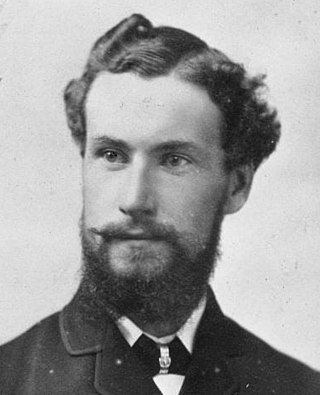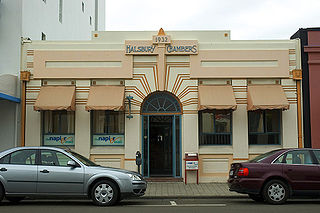
The Distinguished Service Cross (DSC) is a third-level military decoration awarded for gallantry during active operations against the enemy at sea to officers; and, since 1993, ratings and other ranks of the British Armed Forces, Royal Fleet Auxiliary and the British Merchant Navy have been eligible. The award was formerly also awarded to members of armed forces of other Commonwealth countries.
Royal Australian Naval Volunteer Reserve (RANVR) was a reserve force of the Royal Australian Navy.
Architecture of New Zealand is the built environment of regions, cities and towns of New Zealand.

Lewis Tilleard Natusch, but always known as Charles Natusch, was a noted New Zealand architect and quantity surveyor, known particularly as a builder of fine houses for wealthy clients.

Vice Admiral Sir Peter Phipps, was a senior officer of the Royal New Zealand Navy (RNZN) from the 1940s to 1960s.

John Campbell was a New Zealand architect, responsible for many government buildings in New Zealand, among them the Dunedin Law Courts, the Public Trust Building in Wellington, and Parliament House. From 1909 until his retirement in 1922 he held the position of government architect.

Sir Arthur Owen Woodhouse was a New Zealand jurist and chair of government commissions.

James Augustus Louis Hay was a prominent New Zealand architect. He designed many new Art Deco buildings in Napier after the 1931 earthquake that had destroyed much of the town.

Thomas George Fuller (1908–1994) was a Canadian captain of the Royal Canadian Naval Volunteer Reserve who earned renown in the Second World War for his actions as a member of the Coastal Forces of the Royal Navy in European waters. Born in Ottawa, Fuller joined the Royal Canadian Naval Volunteer Reserve in 1939 and was seconded to the British Royal Navy. During his service with the Royal Navy he commanded motor torpedo boat flotillas in European waters, serving with distinction in the Adriatic Sea where he earned a Distinguished Service Cross and two bars along with the nickname "Pirate of the Adriatic." Following the war, Fuller commanded two Canadian Naval Reserve Divisions before retiring in 1952. Following his military service, Fuller ran Thomas Fuller Construction which was instrumental in the construction of several landmark buildings in Ottawa. He was also a member of Ottawa's Britannia Yacht Club and converted and built two brigantines that would later be used for sail training. Fuller died in Ottawa at the age of 85.
John Thomas Mair was a New Zealand architect. From 1923 until his retirement in 1941 he held the position of Government Architect.
Commodore George Raymond Davis-Goff was a senior officer in the Royal New Zealand Navy (RNZN).

Ronald Fong Sang was a New Zealand architect, art collector, art exhibitor and publisher of New Zealand art books.

MTG Hawke's Bay Tai Ahuriri is a museum, theatre and art gallery in Napier in New Zealand. MTG Hawke's Bay occupies three buildings that were redeveloped in 2013.

Heathcote George Helmore was a notable New Zealand architect.
The 1951 New Year Honours in New Zealand were appointments by King George VI on the advice of the New Zealand government to various orders and honours to reward and highlight good works by New Zealanders. The awards celebrated the passing of 1950 and the beginning of 1951, and were announced on 1 January 1951.
The 1952 Queen's Birthday Honours in New Zealand, celebrating the official birthday of Elizabeth II, were appointments made by the Queen on the advice of the New Zealand government to various orders and honours to reward and highlight good works by New Zealanders. They were the first birthday honours of the new queen's reign, and were announced on 5 June 1952.
Allan Arthur Wild was a New Zealand architect and architecture academic. He was a founding member of the Architectural Group in Auckland, which made an important contribution to modern architecture in New Zealand, and later served as head of the School of Architecture at the University of Auckland from 1969 to 1993.
The 2003 New Year Honours in New Zealand were appointments by Elizabeth II in her right as Queen of New Zealand, on the advice of the New Zealand government, to various orders and honours to reward and highlight good works by New Zealanders, and to celebrate the passing of 2002 and the beginning of 2003. They were announced on 31 December 2002.

Laurence Jeremy Elder Salmond was a New Zealand conservation architect. He received the NZIA Gold Medal, the highest honour in New Zealand architecture, in 2018.
Natusch is a surname. Notable people with the surname include:











